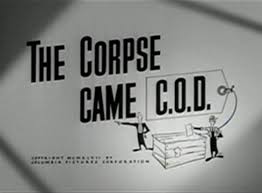IMDB meta-data is runtime of 1 hour and 27 minutes, rated 6.2 by 197 cinematizens.
Genre: Mystery, Comedy

Verdict: ‘Sunset Boulevard’ Lite.
A streamer trunk arrives at the estate of a glamorous Hollywood peroxide star who swans around in a diaphanous wardrobe. The delivery man demands payment, Cash On Delivery. Irritating that, since the trunk contains fabrics for costumes to be used in an upcoming production, but she writes a cheque. (Look it up under either ‘cheque’ or ‘check.’)
Then her factotum prises the case open to reveal, among the bolts of cloth, a corpse! Screaming and gasping follow on cue.
Worse the deadman is the very unpleasant costume designer with whom Peroxide had an argument about wardrobe the day before. Factotum reaches for the telephone but…’No,’ she says and called a newspaper reporter Boyfriend (he wishes) and who takes over control.
After insuring a scoop for his byline he calls the law in the person of Detective Baritone who goes all Dragnet.
Even as Boyfriend investigates he trips over a newshound rival, played by the one and only Joan Blondell. The pratfalls are predictable, as are the fisticuffs, and the red herrings but it is all done with so much joie de vive to make it seem fresh.
There are in-jokes as the two journalists compete for information around the studio lot. The running gang of the convict escape scene did finally end with the man who came to sing! Nice.
Marvin Miller is a superb villain, before he went to work for Mr Tipton giving away moolah. Though the major villain is….. Well, the fraternity brothers figured it out before the denouement because it was telegraphed nearly from the start.
Peroxide is a wall flower when in the same scene with the firecracker Blondell. Even dim Boyfriend figures that out.
The picture starts like a publicity film for Hollywood with references to the dominate gossip and newspaper columnists of the time, like Luella Parsons and Hedda Hopper and then arrives at the estate mentioned above. There is no further reference to the figures reviewed in that five minute overture, which, by the way, included the screenwriter of this piece. If there is a backstory to explain this introduction it did not reveal itself to me.
The anonymous New York Times review of 17 August 1947 is as exhausted and disdainful as most of the reviews carried by that organ. It adds nothing.
Skip to content
